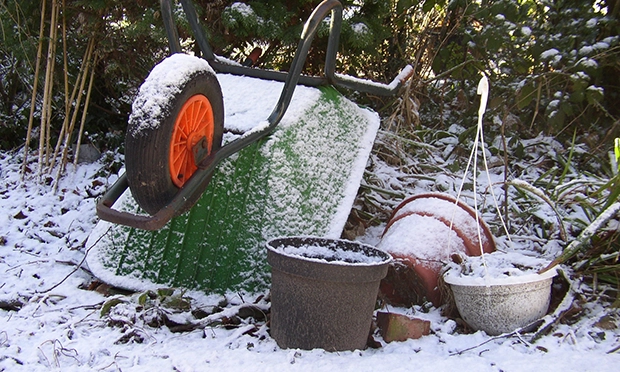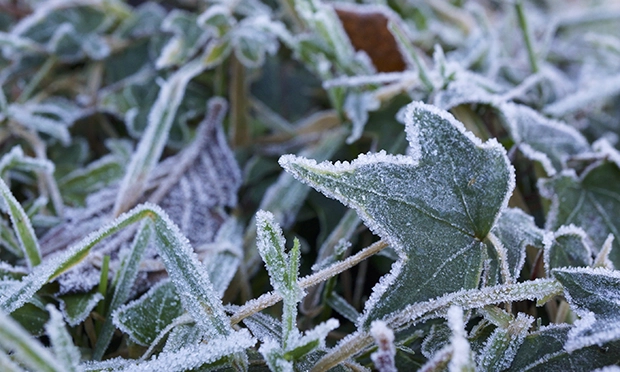The Citizen Gardener: Planting the flowerbeds from bed

Winter tools
I’ve been waddling determinedly around the garden over the past few weeks, my body wrapped in layers of fleece and waterproofs.
I’m so bundled up, I can barely bend, let alone get stuck into some proper gardening. Not that there is much of that to do at the moment anyway, aside from pruning fruit trees and roses.
The plants too are wrapped up warm – the greenhouse has its winter layer of bubble wrap, and the tender plants are keeping cosy under their fleecing.
As I waddle, I take in the stillness that has fallen over the space.
Static form and strong lines have taken over the frilly, bouncy energy of the flowers and foliage of the past growing season. This minimalism provides a rare opportunity to see clearly what is planted in the garden.
With the leaves gone, you can see through the frosty branches to plants long forgotten, and take stock of what is there, while dreaming of what to add this growing year.
Eventually, the cold wins the battle and I take myself indoors, only to stand at the window staring out at the silent, still plot, trying to conjure in my mind a vision of the garden in bloom.
I picture the bare sticks and seed heads full of life and scent, and I imagine the garden’s colour palate; how the tones and textures will work together when the days eventually lengthen. Like the glimpse of a bulb pushing its way through the frozen soil, imagining the garden in its full summer romp is a mood-lifter during these darker, colder days.
From there I take myself deeper inside, in search of warmth, to the kitchen. A room with a windowsill that is sunny enough to house some newly sown seeds. This is my kind of mid-winter gardening, not least because it can be done indoors.
For now, I’m sowing cobaea scandens, otherwise known as the cup-and-saucer vine – a fast growing flowering climber that, sown early in the year, will quickly cover a wall with beautiful blooms.
After the final frosts, usually mid-March in Hackney, I’ll plant it out in containers, with some trellising leaning against a wall for it to climb up.
But still, the kitchen is chilly. Truly, the only spot with guaranteed cosy-factor is the bed (indeed, I am writing this from bed). And until the outdoor temperature gets higher, or the energy prices get lower, I will remain here, cocooned and content.

‘Strong lines’ in a frosty garden. Photograph: Ian Kirk
That is not to say that I am not gardening though. The spades and secateurs remain outside, but the image of the skeletal garden is in my mind, fresh from my frosty stroll, and I have a few sheets of paper and some colouring pencils.
I sketch a bird’s eye view of the outdoor space and begin to make a plan, starting with what I already have. I mark in the permanent features, such as buildings, trees and well-established shrubs, the perennials and the pond go in the plan too.
I do some colouring-in, to get a sense of what hues and tones are already there to be worked with. I pop a compass in the top corner, so I know where the warmest part of the garden is (the south-facing side).
I use my blue pencil to shade in the area that becomes water-logged when it rains, and I use my yellow pencil to highlight the sunniest spot.
The neighbour’s wall goes in there too because that’s the area with the best shelter from the wind.
Then, I begin to dream of what I want to add. I find it’s easiest to make a list, to reel off all of the plants of my dreams, and then work out what is best suited to where. I focus on pollinator-friendly, native varieties.
This year I’m buying a lot more drought-tolerant plants too – a lesson learned from the devastatingly hot summer last year.
For the food growing area, I think of what I buy from the greengrocers most often, which helps me think of what I want to grow myself.
Consulting a food growing calendar is useful for this too, so that the plan allows for plenty of produce available for as much of the year as possible. I’ll start with broad beans and finish with kale.
The next step is ordering my loot. I opt for delivery, I have no interest in venturing out into the tundra to get to the garden centre in person.
First, I look for seeds. My favourite retailer for vegetable seeds is Real Seeds. They are a UK business that finds, trials and sells organic heritage seeds. They are all open-pollinated, so you can save the seeds produced at the end of the season, and grow them again the next year.
Then, it’s on to annual flower seeds, Tamar Organics are a personal favourite, as are Rosybee – a plant nursery based in Wales exclusively selling plants that are good for bees and other pollinators.
After that, I start to look for bare-rooted perennials. These are plants that are sold and planted, as the name would suggest, with bare roots, i.e. no soil around their base. They travel well, as the delicate new root growth has yet to start. Also, without the added weight of the soil, they are a cheaper and more sustainable way of buying perennials.
Finally, I roll over and find my new calendar tucked away in my bedside table.
This year, I have a calendar dedicated to the growing year, a purchase prompted by my New Year’s resolution to be more organised in the garden. In it I pencil in sowing and planting dates.
As the season progresses I’ll make notes of the work completed. I’ll add the changing fortunes of the garden, record weather conditions, pest attacks and other accidents of nature.
Perhaps most importantly, I’ll record the results of my labour, the colour and form, the flavour, texture and yield of each variety. Then, when the first frosts come again and curtail my activity, and the garden slips into restful dormancy once more, I’ll reach for the calendar again, tucked away in my bedside drawer, awaiting another gardening session from under the covers.
Steph Goward is a trained, award-winning gardener. She is the new postcode gardener for E5, a horticultural therapist at St Mary’s Secret Garden, and works with a number of gardening groups across Hackney.
